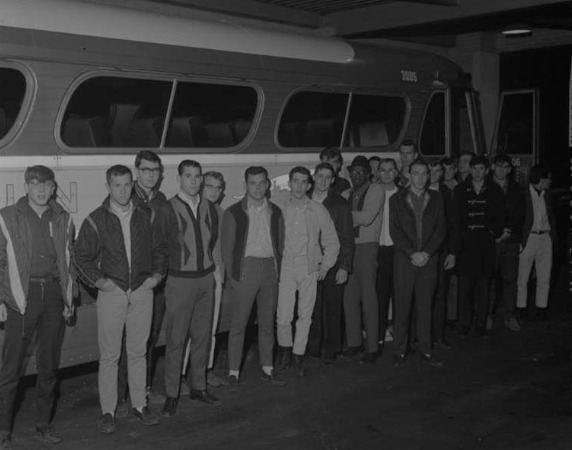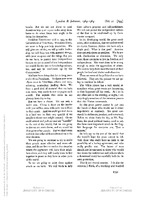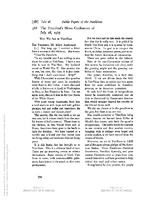If You Get Drafted Can You Get Drafted Again
The Military Draft During the Vietnam War

In November 1965, draftees are leacing Ann Arbor, MI to be processed and sent to basic training camps. The November 1965 draft phone call was the largest since the Korean War.
The Draft in Context
The military draft brought the state of war to the American home front. During the Vietnam War era, between 1964 and 1973, the U.S. military machine drafted 2.two million American men out of an eligible pool of 27 million. Although only 25 pct of the military force in the combat zones were draftees, the system of conscription caused many young American men to volunteer for the armed forces in order to have more of a choice of which sectionalisation in the military they would serve. While many soldiers did support the war, at least initially, to others the draft seemed like a death sentence: existence sent to a war and fight for a cause that they did not believe in. Some sought refuge in higher or parental deferments; others intentionally failed aptitude tests or otherwise evaded; thousands fled to Canada; the politically connected sought refuge in the National Guard; and a growing number engaged in direct resistance. Antiwar activists viewed the draft every bit immoral and the but means for the government to continue the war with fresh soldiers. Ironically, every bit the draft connected to fuel the war effort, it too intensified the antiwar cause. Although the Selective Service's deferment system meant that men of lower socioeconomic continuing were well-nigh probable to be sent to the front lines, no i was completely safe from the draft. Near every American was either eligible to go to war or knew someone who was.

Selective Service consecration
statistics during the Vietnam
War era.
History of the Draft
Conscription during the 1960s took place nether the legal potency of the peacetime draft, because the United States never formally declared war on North Vietnam. Legal authority for a peacetime draft came from the Selective Training and Service Act of 1940, signed past President Franklin Roosevelt in order to mobilize American civilian-soldiers in anticipation of entry into Earth War II. During the Korean War, the Selective Service began the policy of granting deferments to college students with an bookish ranking in the summit half of their class. Between 1954-1964, from the end of the Korean War until the escalation in Vietnam, the "peacetime" typhoon inducted more than than 1.4 million American men, an average of more than 120,000 per year. As part of their Cold State of war mission, many state universities required ROTC training by male person students, although campus protests acquired administrators to brainstorm repealing mandatory ROTC in the late 1950s and early on 1960s.
President John F. Kennedy, who began the escalation of the American military presence in Vietnam, as well defended the peacetime typhoon and the Selective Service in 1962 argument, stating that "I cannot recollect of whatever co-operative of our government in the terminal two decades where in that location take been and then few complaints about inequity." One year later on, the Pentagon best-selling the usefulness of conscription, because one-third of enlisted soldiers and two-fifths of officers "would not have entered the service if not for the draft every bit a motivator." The Selective Service also authorized deferments for men who planned to study for careers labeled as "vital" to national security interests, such as physics and engineering science, which exacerbated the racial and socioeconomic inequalities of the Vietnam-era draft. Of the two.v million enlisted men who served during Vietnam, 80 percentage came from poor or working-grade families, and the aforementioned ratio simply had a high school instruction. Co-ordinate to Christian Appy in Working-Class War , "nigh of the Americans who fought in Vietnam were powerless, working-class teenagers sent to fight an undeclared state of war by presidents for whom they were not even eligible to vote."

In the 1964 Presidential election,
LBJ makes a speechwhere he
promises to not escalate the state of war
in Vietnam.
Broken Promises Atomic number 82 to Discontent
Lyndon Johnson ran every bit the "peace" candidate in his 1964 campaign confronting conservative Barry Goldwater, who wanted to escalate the military offensive against Due north Vietnam and the Viet Cong guerillas. In Oct, at a campaign appearance in Ohio, Johnson promised that "we are not nigh to transport American boys ix or 10,000 miles abroad from home to do what Asian boys ought to be doing for themselves." But in the months after the Gulf of Tonkin Resolution, Johnson chop-chop increased the U.S. military presence in the defense of South Vietnam, with 184,000 troops stationed there by the end of 1965. During that pivotal year, while UM professors organized the first Vietnam teach-in and Students for a Autonomous Club launched the campus antiwar movement, the U.S. war machine drafted 230,991 more young men. During the next four years, the Selective Service inducted an average of around 300,000 immature men annually--including a significant percentage of the 58,156 American troops who would die in the conflict.
America Had No Choice But to Escalate?
In July 1965, at the commencement of this steady escalation, President Johnson attempted to explicate the need for increased military intervention in Vietnam in a press conference announcing that draft inductions would increase from 17,000 to 35,000 per month. LBJ started his address by quoting a letter from an American mother asking why her son had to serve in Vietnam for a cause that she did not empathize. The president rephrased the question in his own words: " Why must young Americans, born into a land exultant with promise and with gilded promise, toil and endure and sometimes die in such a remote and afar place?" Johnson lamented his responsibility "to ship the flower of our youth, our finest young men, into boxing" and said he knew "how their mothers weep and how their families sorrow." Simply, he explained, America had no option, because North Vietnam and Communist China sought to "conquer the Southward, to defeat American power, and to extend the Asiatic dominion of communism. . . . An Asia and so threatened past Communist domination would certainly imperil the security of the The states itself."

President LBJ discusses why the
U.Due south. is at state of war with Vietnam in a
1968 speech communication entitled, "Why Are
We in Vietnam?"
Feelings Towards the Typhoon
The military typhoon and the escalation of the Vietnam war played a major role in turning direct activity resistance into a mass motion on college campuses in the mid-1960s, including at the University of Michigan. In a 1965 Michigan Daily article, experts unveiled the fear that the military was not receiving enough volunteers and recognized the need to make military service more attractive to well-educated Americans, not but to those who had no other option but enlistment or induction. Bill Ayers, a UM pupil activist who was arrested in a 1965 sit-in at the Selective Service Office, discussed how conscription can actually benefit society in a 2022 interview. First, he argued, because the draft affects the people effectually an individual, they are more likely to pay attention to the foreign policy decisions existence fabricated by the government. Therefore, Americans in the era of the draft were much more actively engaged in politics and in questioning the truthful consequences of foreign policy decisions. Second, Ayers pointed out that an all-volunteer war machine has created a poor man's army, because enlistment is attractive to individuals who have no other options because they are poor or uneducated.
Bill Ayers says the draft fabricated people, who were ordinarily
unaware of U.S. foreign policy decisions, more concious to
what was going on.
On Dec 1, 1969, the start draft lottery since 1942 began, simply college deferments were kept intact. Anti-war activists recognized the draft lottery system did not produce truly random results. The typhoon received even more resistance as dissenters became more frustrated with the organization. Finally, Nixon concluded the typhoon in January 1973, but by and so the war was virtually over.
Citations for this page (individual document citations are at the full document links).
1. Michael South. Foley, Against the War machine: Draft Resistance during the Vietnam State of war (Chapel Hill: University of North Carolina Printing, 2003), esp. pp. 35-twoscore; Christian G. Appy, Working-Class State of war: American Combat Soldiers and Vietnam (Chapel Hill: University of North Carolina Press, 1993), esp. pp. 1-43 (quotation p. 27).
ii. Selective Service System, "Induction Statistics, < https://www.sss.gov/induct.htm >, accessed Apr 26, 2015.
three. Lyndon B. Johnson, "Remarks in Memorial Hall, Akron University," October 21, 1964, Public Papers of the Presidents of the United states , 1964, Book 2, pp. 1391-1393
4. Lyndon B. Johnson, "The President's News Briefing: Why Are Nosotros in Vietnam?" July 28, 1965, Public Papers of the Presidents of the U.s. , 1965, Volume II, pp. 794-803 .
5. "Experts See Changes Needed in Draft Policy," Michigan Daily , May 20 1965.
half dozen. Interview of Bill Ayers by Obadiah Brown and Chris Haughey, March 26th, 2015.
ackermanwheas2002.blogspot.com
Source: https://michiganintheworld.history.lsa.umich.edu/antivietnamwar/exhibits/show/exhibit/draft_protests/the-military-draft-during-the-
0 Response to "If You Get Drafted Can You Get Drafted Again"
Postar um comentário